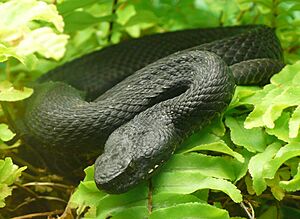Vipera kaznakovi facts for kids
Quick facts for kids Vipera kaznakovi |
|
|---|---|
 |
|
| Conservation status | |
| Scientific classification | |
| Genus: |
Vipera
|
| Species: |
kaznakovi
|
| Synonyms | |
|
|
The Caucasus viper (scientific name: Vipera kaznakovi) is a type of venomous snake. It belongs to the Viperidae family, which includes many vipers. This snake is special because it lives only in certain areas. It is found in Turkey, Georgia, and Russia. People also call it Kaznakow's viper or Kaznakov's viper. There are no different types (subspecies) of this snake known today.
Contents
What's in a Name?
The scientific name, kaznakovi, honors a Russian naturalist named Aleksandr Nikolaevich Kaznakov. A naturalist is someone who studies nature.
How to Spot a Caucasus Viper
The Caucasus viper is a fairly thick-bodied snake. Male vipers are usually shorter and thinner than females. Adult vipers can grow up to about 65 to 70 centimeters (25 to 27 inches) long. However, they are often smaller than this. For example, one study found the largest male was about 47.5 cm (18.7 in) long. The largest female was about 60 cm (23.6 in) long.
Different Names for the Caucasus Viper
Besides Caucasus viper, people also call this snake by other names. These include Kaznakow's viper, Kaznakov's viper, and Caucasus adder.
Where the Caucasus Viper Lives
You can find the Caucasus viper in northeastern Turkey, Georgia, and Russia. Specifically, it lives along the eastern coast of the Black Sea. The first place this snake was officially found was in an area called Tsebelda, near Sukhumi, in Georgia.
Home and Habits of the Caucasus Viper
The Caucasus viper likes to live on forested mountain slopes. It also lives in wet ravines and in clearings where forests used to be. You might find it in groves of azalea and cherry trees. It also lives in mixed forests with evergreen plants. Chestnut, beech, willow, and alder woods are also common homes. These snakes can be found near riverbanks and on rocky slopes.
At higher altitudes, the viper reaches the edge of coniferous forests. However, it does not go deep into these types of forests. It can also be found where beech and fir forests meet grassy areas. Sometimes, you might even see them in areas where tea is grown.
Life Cycle and Hibernation
On the Black Sea coast, these vipers wake up from hibernation in March. Hibernation is like a deep sleep during winter. If they live higher up in the mountains, they wake up later. This usually happens in late April or early May.
They start to reproduce from late March to mid-May. The young vipers are born in late August or early September. Coastal vipers begin their hibernation in early November. Those living in the mountains start earlier, in late September or early October.
Why the Caucasus Viper Needs Our Help
The Caucasus viper is an endangered species. This means it faces a very high risk of disappearing from the wild soon. Its population has dropped by at least 50% over the last 10 years. This is due to several reasons.
Main Threats to the Viper
One big problem is that people illegally collect these vipers. They are taken from their homes to be sold as pets around the world. This is a major threat to their survival.
Another threat is that their homes are being destroyed. Forests are cut down for new buildings, tourist resorts, and farms. This is happening a lot along the Black Sea coast. Many groups of vipers have already disappeared from these areas. Building new houses and expanding farms are big problems. In Turkey, new dam projects also threaten the viper's habitat.
How Reproduction Affects Survival
The way these vipers have babies also makes them vulnerable. Caucasus vipers are viviparous. This means the mother carries her babies inside her body until they are born alive. If a mother viper is hurt or killed, all her babies are affected. This is different from snakes that lay eggs (oviparous). If an egg-laying mother is harmed, her eggs might still survive.
Because of these threats, the Caucasus viper is listed as strictly protected. This is under an agreement called the Berne Convention.


